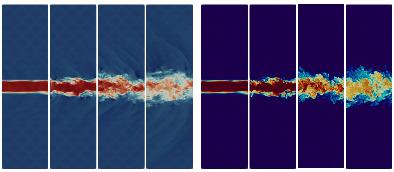当前位置:
X-MOL 学术
›
Int. J. Numer. Methods Fluids
›
论文详情
Our official English website, www.x-mol.net, welcomes your
feedback! (Note: you will need to create a separate account there.)
Implicit large eddy simulation of passive scalar transfer in compressible planar jet
International Journal for Numerical Methods in Fluids ( IF 1.7 ) Pub Date : 2020-10-07 , DOI: 10.1002/fld.4924 Youming Tai 1 , Tomoaki Watanabe 1 , Koji Nagata 1
International Journal for Numerical Methods in Fluids ( IF 1.7 ) Pub Date : 2020-10-07 , DOI: 10.1002/fld.4924 Youming Tai 1 , Tomoaki Watanabe 1 , Koji Nagata 1
Affiliation

|
Implicit large eddy simulation (ILES) of passive scalar transfer in compressible turbulence is evaluated for subsonic and supersonic turbulent planar jets. The ILES used in this study relies on fully explicit numerical schemes for spatial and temporal discretization and low‐pass and shock‐capturing filters used as an implicit subgrid‐scale (SGS) model. The ILES results are compared with the direct numerical simulation (DNS) database of the same flows. The ILES results exhibit good agreements with the DNS for first‐ and second‐order statistics of velocity and passive scalar. The scalar transport by turbulent velocity fluctuations is well captured by the ILES. The temporal evolution of the jet strongly depends on the jet Mach number, where a higher Mach number results in the delay of jet development. The Mach number dependence of velocity and passive scalar fields is consistent between the ILES and DNS. The low‐pass filters used as the implicit SGS model contribute to the dissipation of turbulent kinetic energy and scalar variance. Under the present numerical conditions, the filters account for about 50% of the dissipation in a fully developed turbulent jet. The dissipation rate in the ILES, which is the sum of the grid‐scale and SGS dissipation rates, is very close to the dissipation rate in the DNS, and the amount of the SGS dissipation is well controlled by the low‐pass filters. The filters also dump numerical oscillations in the velocity field caused by strong pressure waves outside the supersonic jet at the high Mach number.
中文翻译:

可压缩平面射流中被动标量传递的隐式大涡模拟
对于亚音速和超音速湍流平面射流,对可压缩湍流中被动标量传递的隐式大涡模拟(ILES)进行了评估。本研究中使用的ILES依赖于用于空间和时间离散化的完全明确的数值方案,以及用作隐式子网格规模(SGS)模型的低通和冲击捕获滤波器。将ILES结果与相同流的直接数值模拟(DNS)数据库进行比较。ILES结果与DNS的速度和被动标量的一阶和二阶统计数据显示出良好的一致性。ILES很好地捕获了由湍流速度波动引起的标量传输。射流的时间演变在很大程度上取决于射流的马赫数,其中较高的马赫数导致射流发展的延迟。速度和被动标量场的马赫数相关性在ILES和DNS之间是一致的。用作隐式SGS模型的低通滤波器有助于消散湍动能和标量方差。在目前的数值条件下,过滤器约占完全形成的湍流射流中耗散量的50%。ILES中的耗散率是网格规模和SGS耗散率的总和,非常接近DNS中的耗散率,并且SGS耗散的数量由低通滤波器很好地控制。过滤器还会以高马赫数在超音速喷射器外部倾倒强大的压力波引起的速度场中的数值振荡。用作隐式SGS模型的低通滤波器有助于消散湍动能和标量方差。在目前的数值条件下,过滤器约占完全形成的湍流射流中耗散量的50%。ILES中的耗散率是网格规模和SGS耗散率的总和,非常接近DNS中的耗散率,并且SGS耗散的数量由低通滤波器很好地控制。过滤器还会以高马赫数在超音速喷射器外部倾倒强大的压力波引起的速度场中的数值振荡。用作隐式SGS模型的低通滤波器有助于消散湍动能和标量方差。在目前的数值条件下,过滤器约占完全形成的湍流射流中耗散量的50%。ILES中的耗散率是网格规模和SGS耗散率的总和,非常接近DNS中的耗散率,并且SGS耗散的数量由低通滤波器很好地控制。过滤器还会以高马赫数在超音速喷射器外部倾倒强大的压力波引起的速度场中的数值振荡。ILES中的耗散率是网格规模和SGS耗散率的总和,非常接近DNS中的耗散率,并且SGS耗散的数量由低通滤波器很好地控制。过滤器还会以高马赫数在超音速喷射器外部倾倒强大的压力波引起的速度场中的数值振荡。ILES中的耗散率是网格规模和SGS耗散率的总和,非常接近DNS中的耗散率,并且SGS耗散的数量由低通滤波器很好地控制。过滤器还会以高马赫数在超音速喷射器外部倾倒强大的压力波引起的速度场中的数值振荡。
更新日期:2020-10-07
中文翻译:

可压缩平面射流中被动标量传递的隐式大涡模拟
对于亚音速和超音速湍流平面射流,对可压缩湍流中被动标量传递的隐式大涡模拟(ILES)进行了评估。本研究中使用的ILES依赖于用于空间和时间离散化的完全明确的数值方案,以及用作隐式子网格规模(SGS)模型的低通和冲击捕获滤波器。将ILES结果与相同流的直接数值模拟(DNS)数据库进行比较。ILES结果与DNS的速度和被动标量的一阶和二阶统计数据显示出良好的一致性。ILES很好地捕获了由湍流速度波动引起的标量传输。射流的时间演变在很大程度上取决于射流的马赫数,其中较高的马赫数导致射流发展的延迟。速度和被动标量场的马赫数相关性在ILES和DNS之间是一致的。用作隐式SGS模型的低通滤波器有助于消散湍动能和标量方差。在目前的数值条件下,过滤器约占完全形成的湍流射流中耗散量的50%。ILES中的耗散率是网格规模和SGS耗散率的总和,非常接近DNS中的耗散率,并且SGS耗散的数量由低通滤波器很好地控制。过滤器还会以高马赫数在超音速喷射器外部倾倒强大的压力波引起的速度场中的数值振荡。用作隐式SGS模型的低通滤波器有助于消散湍动能和标量方差。在目前的数值条件下,过滤器约占完全形成的湍流射流中耗散量的50%。ILES中的耗散率是网格规模和SGS耗散率的总和,非常接近DNS中的耗散率,并且SGS耗散的数量由低通滤波器很好地控制。过滤器还会以高马赫数在超音速喷射器外部倾倒强大的压力波引起的速度场中的数值振荡。用作隐式SGS模型的低通滤波器有助于消散湍动能和标量方差。在目前的数值条件下,过滤器约占完全形成的湍流射流中耗散量的50%。ILES中的耗散率是网格规模和SGS耗散率的总和,非常接近DNS中的耗散率,并且SGS耗散的数量由低通滤波器很好地控制。过滤器还会以高马赫数在超音速喷射器外部倾倒强大的压力波引起的速度场中的数值振荡。ILES中的耗散率是网格规模和SGS耗散率的总和,非常接近DNS中的耗散率,并且SGS耗散的数量由低通滤波器很好地控制。过滤器还会以高马赫数在超音速喷射器外部倾倒强大的压力波引起的速度场中的数值振荡。ILES中的耗散率是网格规模和SGS耗散率的总和,非常接近DNS中的耗散率,并且SGS耗散的数量由低通滤波器很好地控制。过滤器还会以高马赫数在超音速喷射器外部倾倒强大的压力波引起的速度场中的数值振荡。











































 京公网安备 11010802027423号
京公网安备 11010802027423号